QuestionI read somewhere that you can feed them spiders. What type of spiders can be fed to the gecko and also what other types of insects? Will they eat sow bugs (rolly pollys)? We have a ton of them in our yard.
Hey thank you so much for all the expertise!
Eve
T
-------------------------------------------
The text above is a follow-up to ...
-----Question-----
Is it necessary to provide a humidity spot? Can you put real plants in the cage, if so what type?
-----Answer-----
Hi Eve,
Yes, its very important to provide a humid hide for your leo. The humid hide is what helps them to shed in one piece like they are suppose to. Without the humid hide, the shed sticks and can cause their toes to be cut off due to lack of blood supply from the shed that doesn't come off properly. The hide doesn't have to be anything fancy...in the care sheet below I give some ideas on making one.
You can put live plants in, but...you have to make sure that they won't raise the humidity in the entire cage. Plants like succulents (cactus) that have no spines at all would be a fair choice if you want to include some live plants. The leo will crawl on them, which will most likely break the plants...its why I choose to use the silk fake ones!! They make some fake cacti that look wonderful in the leos tanks which they climb on and can't destroy them nor harm the leos.
BASIC CARE FOR A LEOPARD GECKO
Leopards are pretty easy to care for but they do need
special care. Here are some of the basic needs of your
gecko.
HOUSING: The need to have at least a 20 gallon long tank for
one Leo. This needs to have a secure fitting screen top...they can be quite the escape artists!!! They need to have a humid hide box.You can make
this with something as simple as a small plastic dish with a
hole cut in one side and a small mesh bag filled with some
Sphagnum moss, coconut bark or Peat moss that you mist.
I made mine out of the small plastic folgers coffee containers...I cut an opening in the lid..and put the moss in..they LOVE it. I use the terrarium moss in mine.
I use that on the warm side of the tank. Be sure to provide a cool hidebox on the other end. I also provide a mid temperature hide...which is in the middle of the tank.I use the critter caves which you can purchase. NOT the ones that have heat in them!!!!
Provide secure climbing areas for your gecko. Fake plants, rocks and branches are all fine to use. be sure there are no wires or sharp ends to any fake plants you use.
SUBSTRATE:(that's the stuff on the floor of your tank) News
paper, lizard carpet or paper towels work great and are easy
to clean and are much safer than any loose substrate. Sand or other loose substrate is not recommended as that they can be deadly to the leo when it is ingested(eaten, even by accident while eating their insects)...
TEMPERATURES: They need a warm area of 88-92 degrees and a
cooler area in the upper 70s, low 80s. At night their
temperature can drop to the low to mid 70's.
Never use a hot rock for a leopard gecko...or any reptile.
They can severely burn any reptile. You can use a heating
pad under the tank,under tank heater, or you can use a regular household
lightbulb in a dome fixture with a ceramic socket in it to
keep the warm area at the 88-90 degree area.At night, no white light. If room temperatures stay above 70 degrees, no extra night heat is needed. The undertank heater or heating pad should cover about 1/3 of the tank....be sure to raise the tank up about 1/4-1/2 inch off the stand when using an undertank heat source to prevent heat build up which can cause the glass to break and hot spots in the glass. Be sure to have a good layer of newspaper, carpeting or, even a thin flat rock(such as tile) on top the area that the undertank heat source is placed...if you use a thin rock or tile, it helps to distribute the heat very well.
You can use the special nighttime lights that are designed for reptiles. I like using a ceramic heat emitter on a thermostat for nighttime heat.
DO NOT use black lights or party lights as they can cause eye damage!!!!
The wattage you use will vary based on room temperature and size of tank.
LIGHTING: Leopard geckos do not need UVB lighting but it does not hurt them to give them uvb. They should have some type of light during the day, be it a uvb tube, regular florescent light, reptile day light or regular household lightbulb. NO white lights at night!!!
FEEDING: Geckos should not be fed crickets or other insects that are bigger than the space between their eyes. Crickets and other food items such as silk worms, super, and an occasional treat of a wax worm, need to be dusted with a calcium supplement two times a week and also they should have a small dish of calcium in their tank. I use the lid of a milk jug for the little dish of calcium in their tank. For dusting the insects, Use a calcium with no added phosphorus.
Insects must be gut loaded(fed) for at least 48 hours prior to feeding your gecko. Remove any uneaten crix or superworms after 15-20 minutes..... Place a piece of cut potato in the tank so that if you have missed any uneaten insects, they will eat the potato instead of nibbling on your gecko!!!
You have to be sure to feed your crickets the right foods
before feeding them to your gecko. If your crickets/insects are not healthy and well fed, your gecko will not get the nutrition
he needs. You can gut load your crickets greens, veggies, cereals or specially designed commercial foods for crickets or the insects you are feeding.
Be sure to have a small dish of clean water for your gecko
at all times!!
You can offer them some baby food or fruits on occasion ...
Mine will even eat a small piece of watermelon now and then.
WATER: always provide a dish of drinking water. If you choose to mist your gecko to drink, its best to not get the tank too wet as that they do not do well with higher humidity. Sometimes its better to take your leo out of their tank to mist them to get them to drink!!!
HANDLING: Some geckos enjoy being held...others prefer not to be handled at all. Be sure to be very gentle when holding your leo and NEVER grab them by the tail! Their tails are extremely fragile and will break.
I do suggest finding a vet that can treat reptiles BEFORE you actually need one!!! To find a vet that is able to care for reptiles:
http://www.anapsid.org/vets
http://www.arav.org/Directory.htm
For more information on leopard geckos:
http://www.thegeckospot.com/leocareindex2.html
http://www.drgecko.com
If you have any more questions, or don't understand something, please let me know!!
Please let me know how I did answerign your questions!
AnswerHi Eve,
I've not read that about feeding spiders but I am sure that in the wild they would eat them. The problem is, knowing what would be safe for them and then being able to 100% identify them as being safe for them. Best to stay away from them. With insects from our yards the problem is...even if we know we don't use any pesticides, etc in our yards, we don't know where the insects were before they came to our yards. Best to not feed any insects from the wild.
You can feed them crickets, mealworms(fresh shed ones which are nearly pure white) superworms, silk worms, phoenix worms, Black crickets, Locusts ,roaches ,Wax worms(limited amt on occasion as they are too high in fat content)They need to have a variety of insects in their diet to maintain correct nutritional balance. No one insect can maintain a leo for their entire life. Any insect must be gut loaded(as explained in my caresheet) prior to feeding them to the leo. Some leos will eat the "canned" insects that you can buy, but that is rare. Never feed them dead insects that were alive when you purchased them to prevent any possible diseases or illnesses.
Hope this helps you out!!!

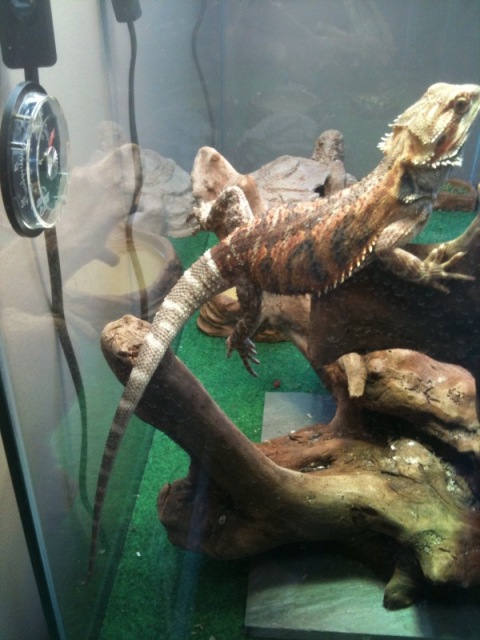 bearded dragon tail turned white
QuestionBDs white tail
QUESTION: My 8 month old
bearded dragon tail turned white
QuestionBDs white tail
QUESTION: My 8 month old
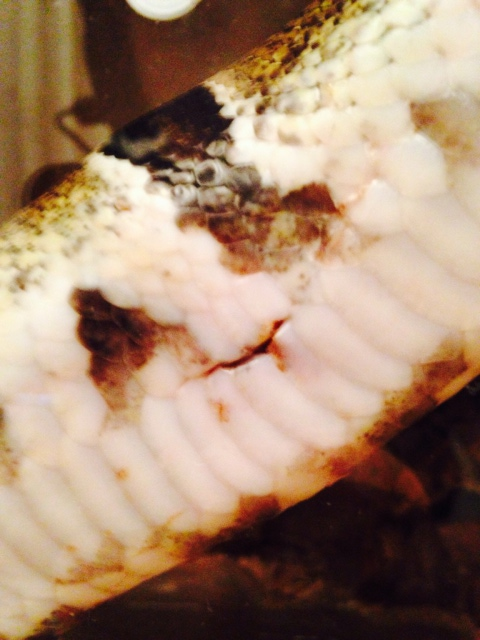 My snake has a large cut/slit in his stomach
Question
His cut
My snake always likes to climb
My snake has a large cut/slit in his stomach
Question
His cut
My snake always likes to climb
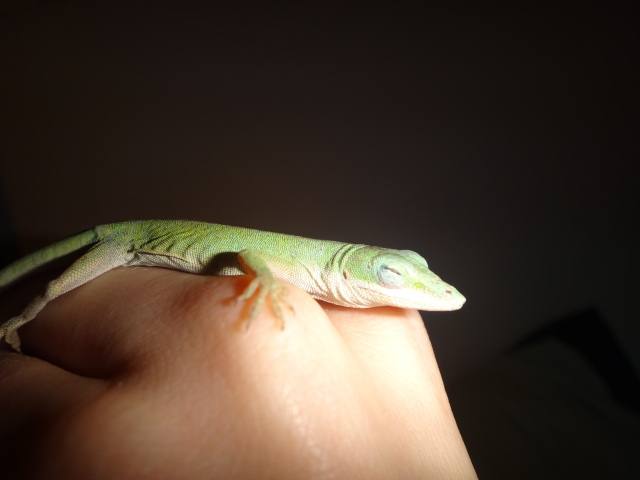 Green Anole with possible eye infection
QuestionQUESTION: I have 5 anoles in a 20 gallon tank w
Green Anole with possible eye infection
QuestionQUESTION: I have 5 anoles in a 20 gallon tank w
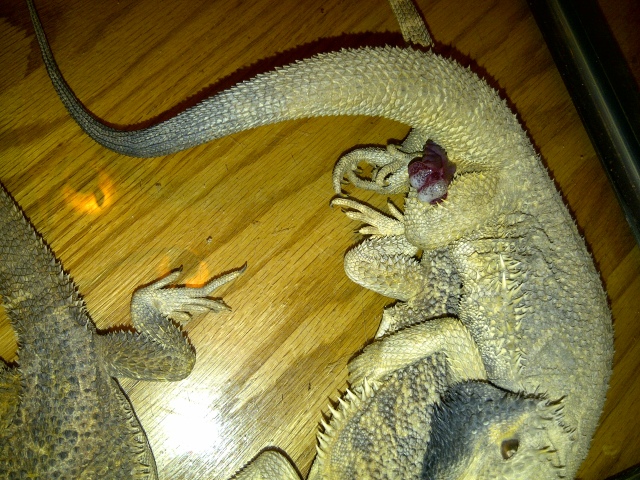 breeding beardies
Questiontrying to get together
QUESTION: I have
breeding beardies
Questiontrying to get together
QUESTION: I have
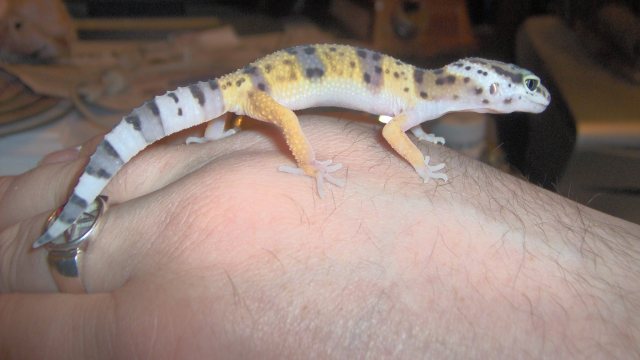 Leopard Geckos and Marking Territory
Question
My leo
Hi! I have a small leopard gecko who I
Leopard Geckos and Marking Territory
Question
My leo
Hi! I have a small leopard gecko who I